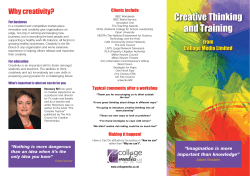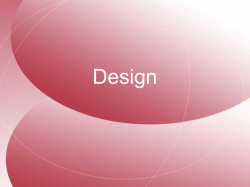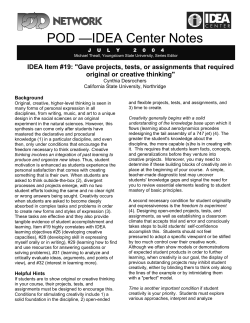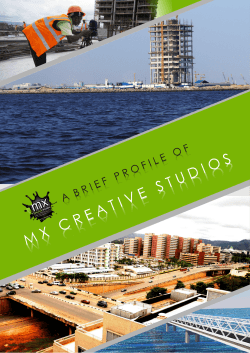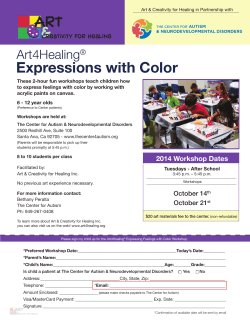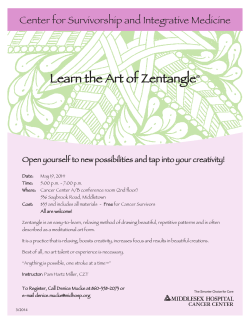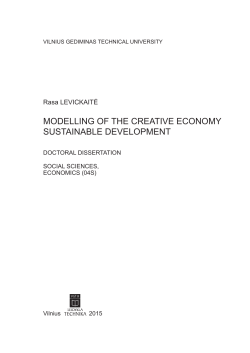
Handout poster EAWOP
Latent Regression Models Control Gender Grade Organisation Grade Organisation Role Project Role Project Stage Project Industry Group Women Administrative Manager Financial Administrator Project participant 75% or more completed Consultants Affective commitment Project Supervisor Organisation Occupation Client Job involvement Career Routine behavior Adjusted R Square LRM 1 LRM 2 LRM 3 Incremental CPE Radical CPE Routine Phase 1 Phase 2 Phase 3 Phase 4 Phase 1 Phase 2 Phase 3 Phase 4 Behavior -.15** -.13** -.14* -.22** -.27** -.15* -.11* -.15** -.15* -.15* -.17** -.16** -.18** -.15* .23** -.23** -.10* -.12* -.11* .21* .25* -.14" .27* -.22* .23* .27** .21* .22* .31** -.14* .29** .25** .40** -.29** .25** .24** -.21* ..36** -.22* .34** .32** .29** .15* .18** .27** .31** .23** .35** .11** .22** " Regression effect is marginally significant at p = 0.052 *effect is significant at the 0.05 level (2-tailed), ** effect is significant at the 0.01 level (2-tailed) Mediation between multiple foci of commitment, 2 types of creativity 2 different models: Incremental Creative Process Engagement (ICPE) in 4 phases: 1.Problem finding 2.Information search 3.Idea generation 4.Idea evaluation Radical CPE Routine Behaviour Problematique Commitment to the organisation has always been a strong predictor of employee behaviour in organisation. However, employment settings are changing towards more networked environments, in which employees interact with parties within and beyond the boundaries of the organisation. In this environment employees are likely to develop commitment to multiple entities. Creative ideas are valued increasingly in all kinds of organizations, and organizations seek to make use of employees’ abilities and creative potential. Employee attitudes, especially the level of commitment, are likely to be central to the willingness to engage in activities central to the creative process. Using a field theoretic lens, this paper explores how employees in may develop feelings of proximity to (inter-organisational) multiple agents such as the organization, the profession, and the client Mediation between multiple foci of Commitment: 2 models for 2 types of creativity Positive or negative relation? Only a few studies have examined the relation between commitment and creativity, and results are inconclusive. Creativity has been projected as a proactive type of extra role behaviour., however, creativity has also been related to autonomy, freedom, and unrestricted thinking. It seems there are arguments to find for a both a positive and a negative relation between commitment and creativity. In other words commitment may help or hinder creativity. Measurement Creativity is measured as the employees’ engagement in creativity relevant cognitive processes (Zhang and Bartol, 2010). The idea is when an employee enacts the activities associated with the creative process, it is more likely a creative product is produced (Zhang & Bartol, 2010a). Based on interviews this measure is extended to include engagement in creative behaviour in four stages of the creative process. Relating to creativity literature, the measure is adjusted to assess both incremental and radical types of CPE (Madjar et al. 2011). Commitment is measured by affective commitment to six foci, the inter-organisational project, the organisation, the occupation, the career, the job and the client. Design and tests The paper relies on individual data from 302 inter-organisational innovation projects funded by the UK government. Three Latent Regression Models are fitted to the data to test the effects of seven foci of commitment on two types of Creative Process Behaviour in four phases of the creative process. Multiple foci of commitment are found to interact in their effect on employee behaviour (Bentein et al., 2002). A series of mediation models are fitted to the data and the best fitting models are compares for the two types of creativity. Contribution The current paper is the first to propose and empirically examine the relations between commitment and creativity using a multiple foci approach. The results demonstrate multiple commitments and CPE are involved in a complex net of relationships among which the project, the job and the career play a central role. Understanding of the relation between commitment and creativity provides a basis of the management of employee commitments, and, thereby managing employees’ creative behaviour Key Literature Commitment Bentein, K., Stinglhamber, F., & Vandenberghe, C. (2002). Organization-, supervisor-, and workgroup-directed commitments and citizenship behaviours: A comparison of models. European Journal of Work and Organizational Psychology, 11(3), 341-362. Klein, H., Becker, T., & Meyer, J. (Eds.). (2009). Commitment in organizations: Accumulated wisdom and new directions: Routledge/Taylor & Francis Group. Lewin, K. (1943). Defining the'field at a given time.'. Psychological Review, 50(3), 292-310. Meyer, J. P., Stanley, L. J., & Parfyonova, N. M. (2012). Employee commitment in context: The nature and implication of commitment profiles. Journal of Vocational Behavior 80(1), 16. Morin, A. J. S., Morizot, J., Boudrias, J. S., & Madore, I. (2011). A multifoci person-centered perspective on workplace affective commitment: A latent profile/factor mixture analysis. Organizational Research Methods. Reichers, A. E. (1985). A review and reconceptualization of organizational commitment Academy of Management Review, 10(3), 465-476. Swart, J., and Kinnie, N. (2012). Committed to Whom? Professional knowledge worker commitment in cross-boundary organizations. Human Resource Management Journal, 22(1), 17. Vandenberg, R. J., Stanley, L. J. (2009). Statistical and Methodological Challenges for Commitment Researchers: Issues of Invariances, Change Across Time, and Profile Differences. In H. Klein, T. Becker & J. Meyer (Eds.), Commitment in organizations: Accumulated wisdom and new directions: Routledge/Taylor & Francis Group. Yvonne van Rossenberg Work and Employment Research Centre School of Management, University of Bath E-mail: ygtvr20@bath.ac.uk Creativity Madjar, N., Greenberg, E., & Chen, Z. (2011). Factors for Radical Creativity, Incremental Creativity, and Routine, Noncreative Performance. Journal of Applied Psychology, 96(4), 730-743. Zhang, X., & Bartol, K. (2010). The influence of creative process engagement on employee creative performance and overall job performance: A curvilinear assessment. The Journal of applied psychology. Zhang, X. M., & Bartol, K. M. (2010). Linking empowering leadership and employee creativity: The influence of psychological empowerment, intrinsic motivation, and creative process engagement. Academy of Management Journal, 53(1), 107-128.
© Copyright 2025
